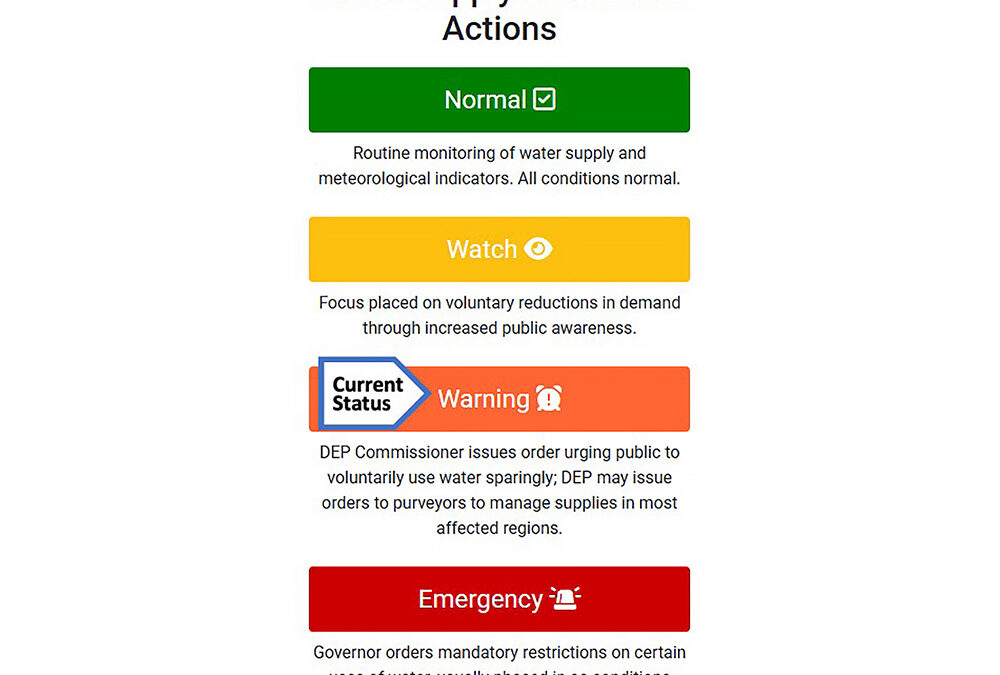By Meteorologist Joe Martucci
Dry January, the annual ritual in which people refrain from drinking alcohol to kick off the new year, extended to Mother Nature as well. However, in her case, the dry January wasn’t about a lack of alcohol, but a lack of precipitation, significantly lowering the chances that we will end the drought by the time spring comes.
Dry on the coast
The Coastal Region of New Jersey, roughly anywhere from the Garden State Parkway on east, including most of Cape May County, had the third or fourth driest January on record, according to the Office of the New Jersey State Climatologist.
Records going back to 1895 show it was among the driest 2-3% of Januarys on record, according to Dave Robinson, the New Jersey state climatologist.
Snow not enough
Don’t be fooled by the snow cover on the ground, the cold weather and lack of watering you did in January. This is bad news for New Jersey.
Every week, January saw either an improvement or no change in its drought status, which is updated by the United States Drought Monitor on Thursdays using data through that Tuesday. That is, on Jan. 30, 15% of the state worsened from a “moderate” drought – a level one of four for drought – to a “severe” drought, a level two. The South Jersey shore remained in the driest condition, located in an “extreme” drought at level three of four. More than a third of the state, 34%, is in this classification, which includes all of Cape May and Atlantic counties, as well as most of Cumberland, Burlington and Ocean counties. Our region has remained in this extreme drought from Nov. 12 through the Jan. 30 update.
While our Feb. 5 status is not known at the time of this writing, there’s no reason to believe our drought status will be better by then. We need around 0.75 inches of rain a week just to stay steady, and more to improve our status. We’re not expected to go much above 0.75 inches by the Thursday update.
I’ve been saying since our winter forecast was released on Nov. 27 that we won’t have enough precipitation to cure drought by the time the winter season is over. Sadly, that’s proving true.
Spring is coming
We have about six more weeks to improve drought fairly easily. Water usage is at an annual minimum and the sun isn’t evaporating much moisture from the ground.
But six weeks from now it will be late March. Water usage will increase as agriculture begins and sprinkler systems come back online. The sun will be stronger and pull moisture out of the ground through evaporation. By this point, we’ll need about an inch of precipitation a week just to keep our drought status steady, and probably 1.5 inches a week to improve drought. That’s a tall order.
The Climate Prediction Center forecasts equal chances of precipitation being either below average, near average or above average for February from their mid-January update. Those equal chances extend to their three-month outlook, which covers February through April. Sure, it’s possible we wind up on the wet side, but don’t place your bets on it. Even average precipitation during this time will bring harm to the state, let alone below average.
Forest fire danger
Prescribed burning will be a challenge to meet the New Jersey Forest Fire Service’s mission to protect “life, property as well as the state’s natural resources from wildfire.” Prescribed burning reduces the risk of future wildfires by skillfully applying fire to reduce the underbrush, which is fire fuel. Typically, this begins in late February and continues through spring.
Most of the Pine Barrens range from a level five to a level nine out of 10 when it comes to burn probability, as of Jan. 31. I expect that to worsen in the next few weeks. If conditions are too dry, it’s hard to conduct prescribed burning, and even skillfully applied fires can spread rapidly. Reduced prescribed burning just means a greater likelihood the inevitable wildfires that do occur this year will be bigger and spread faster.
Dry streams and wells
Many of us have well water once you go offshore. With groundwater conditions running “extremely dry,” according to the New Jersey Department of Environmental Protection (NJDEP), expect this to mean either your well will need to be dug deeper, or risk going dry completely and relying on outside sources of water.
Streamflows have also been suffering under the extremely dry conditions for the past 14 weeks, the NJDEP says. That will impact the amount of oxygen fish and other freshwater marine wildfire can consume. Expect impacts there.
Water restrictions
This one is a policy decision. I’m not a policymaker, nor do I know everything that goes into the decision. However, currently the state is in a drought warning. The next step would be a drought emergency. The last time that occurred was from March of 2002 until January of 2003, according to the state.
The current drought is as significant and severe as it was then, so it’s very possible that we will go into an emergency this spring if drought conditions don’t improve. We already have volunteer water restrictions in effect by New Jersey American Water. A drought emergency doesn’t have to mean water restrictions statewide, but in the 2002-2003 emergency it did.
On June 20, 2002, the state issued mandatory restrictions. They halted commercial power washers, of flushing sewer systems, and mandated odd/even days for watering lawns. Restaurants were told not to serve water unless requested by customers.
I can’t say for sure, but I bet that kind of restriction will take place if precipitation winds up at or below average over the next three months.
Joe Martucci, a Certified Broadcast Meteorologist and Digital Meteorologist, is the President and Director of Meteorology for Cup A Joe Weather and Drone. You can connect with him at cupajoe.live.
















